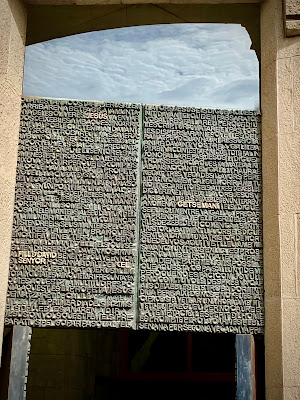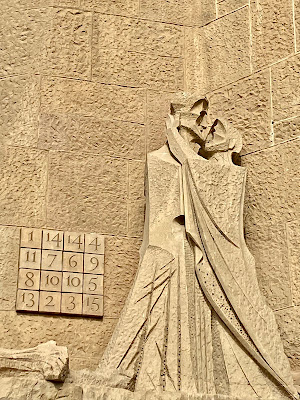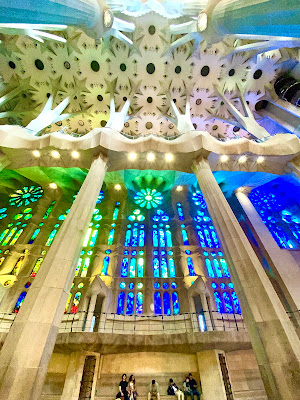 |
| La Sagrada Familia's Door of Crowning with Thorns |
Traveling broadens your horizon. It enriches your mind and your spirit. But traveling uses up a lot of your time and treasure. It would be a waste if you missed something on your trip you should’ve seen or experienced. It happened to me several times and I regretted that so much. If you’re planning a trip, I’d like to help you avoid missing out. So, let my blog show you what to look out for. Prepare for your trip by traveling with me through this post. Or you might still be in the praying and dreaming stage. Manifesting your dream into reality starts here!
A Happy Solo in Barcelona, Spain (Part 2)
“He was an architect…he
wanted to build synagogues, ones with colonnades that sing, parapets that
practically pray, vaunted halls that draw the soul upward to God.” – Nathaniel (The
Chosen Season 2 Episode 2)
I’m a huge fan of The
Chosen, the phenomenal show about Jesus and his disciples. So, Nathaniel’s
words flashed through my mind when I beheld the splendor that is La Sagrada
Familia. They describe Antoni Gaudí and his obra maestra perfectly.
 |
| La Sagrada Familia |
Like I said in my last blog, La Sagrada Familia is so magnificent, it deserves a post especially dedicated to it. So come and be awed with me.
But first, let me share
a few facts about El Templo Expiatorio de la Sagrada Familia (The
Basilica and Expiatory Church of the Holy Family).
The foundation of this
behemoth basilica was laid in 1882. The target date for its completion is 2026 to coincide with the
centennial of the death of Antoni Gaudí, the genius behind this stunning edifice.
It is a UNESCO World Heritage Site as part of the Works of Antoni Gaudí and
also named as a Spanish Cultural Heritage. It is the largest unfinished
Catholic church in the world. Due to its prolonged construction, the crane has
become iconic to the building’s façade. I read a comment from a Barcelona native
that if a photo does not include the crane, it is a fake or AI generated.
The crane is essential
because the towers are still being erected. In La Sagrada Familia, it is not
only the “parapets that practically pray” but its lofty towers, like
upraised hands, laud the heavens with praise.
Fachada
del Nacimiento (Nativity Façade)
Gaudí meant the
basilica to be “the bible made of stone”, to tell the story of Jesus using
imagery – sculptures and visual elements. And looking at the intricate details
of the Nativity Façade, you will be mesmerized by how our Messiah’s early life
is celebrated with the lushness of life that abounds on this earth.
This façade is the only
side of the basilica completed during Gaudí’s lifetime. It has three portals:
· Portal
of Charity depicting the Birth of Jesus with the Holy Family
sculpture, Choir of Angels, Magi and shepherds.
It serves as the main door.
· Portal
of Faith or the Faith of Mary on the right side with scenes of
the Child Jesus preaching, the Visitation and the Presentation.
· Portal
of Hope
or the Hope of Joseph on the left side showing Joseph teaching the young Jesus,
their flight into Egypt and the Slaughter of the Innocents.
Interior
The basilica does not
only have “colonnades that sing” but columns that magnify God’s
creations. Resembling towering trees, they form a forest canopy over the nave.
 |
| Main Nave with Arboriform Columns |
What totally captivated me about the basilica was a feature that Nathaniel missed in his description – windows that spew rainbows.
On the Nativity Façade
side, cool greens and blues illumine the interior.
And on the Passion
Façade side, warm reds, oranges and yellows. Awe-inspiring!
The line “vaunted
halls that draw the soul upward to God” describes the Neo-Gothic Apse
perfectly. The crucifix suspended from the golden baldachin swathed by a breathtaking
tapestry of lights did make my spirit soar.
 |
| Baldachin (the canopy that covers the altar) is heptagonal shaped to represent the 7 gifts of the Holy Spirit |
This video I took of the interior captured an interesting fact about the basilica which makes it distinct from usual Catholic churches: there are only 4 statues. Aside from the Crucified Christ hanging from the baldachin, only the Blessed Mother, St. Joseph and St. George are represented.
Fachada de la Gloria (Glory Façade)
Outside, the Glory Façade
is still under construction. When finished, it will be the main entrance and the
most monumental of the 3 façades meant to depict Jesus’ glory and Ascension. Gaudí’s
vision for it is to be bathed in a kaleidoscope of vibrant colors with a heavenly
host of angels and saints. It’s a sight I fervently pray to see and one of the
reasons why Barcelona made it back to my bucket list.
Inside, you can already
see the vision shaping up. The window above the door, unlike those of the other
two façades, are not colored thus creating an aura of celestial light.
 |
| Bronze statue of St. George, patron saint of Catalonia |
The door, which I’m guessing will be the main entrance, features the Our Father in Catalan in high relief with translations of “Our Father” and “Give us this day our daily bread” engraved around it in 50 languages including Filipino. The handles are the letters “A” and “G” (initials of Antoni Gaudí).
Our group had another
“Proud Pinoy” moment when our tour guide pointed out the holy water fonts. Made
from giant clam shells, they were a gift from the Philippines. The markers stated,
“Alay ng Sambayanang Pilipino”. Imagine a piece of our country
contributing to this grandeur.
Fachada
de la Pasión (Passion Façade)
Stepping out of the
church to view the Passion Façade, we felt a completely different vibe. Its harsh
angular lines and severe images evoked the pain and suffering of Jesus’ last
days on earth.
Gaudí included skeletal
forms in his design. He wanted it to be “hard, bare and made of bones”.
 |
| Skeletal Pillars of the Passion Façade |
 |
| Cast bronze door inscribed with the text in Catalan of the Passion of Christ according to the Gospels of Matthew and John |
 |
| Sanhedrin Trial of Jesus |
 |
| Kiss of Judas and a Magic Square that adds up to 33 across or down |
La Sagrada Familia was not just a sight but an experience – one of joy, of glory and of sorrow. It is a place you must visit at least once in your lifetime.
To fully embed that experience in my heart, I painted irises inspired by the bronze door of the Nativity portals which was designed by Japanese sculptor Etsuro Sotoo. It featured delicate flowers, leaves and whimsical creatures nestled among them.
Postscript: I was not
happy with the original painting that I posted here so I made a lighter, airier
version. In the first painting, I tried to stay true to the model set in bronze,
to capture its metallic, harder lines but got lost along the way (part of my
journey of #10000Hours). This new version is more in tune with the celestial
aura of the Glorious Façade, so I dubbed it “Gloriosa Iris de la Sagrada
Familia”.












No comments:
Post a Comment